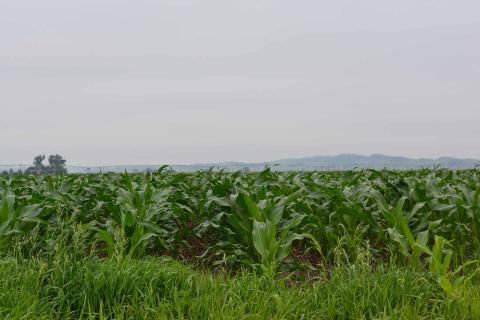Around the world and across Nebraska, nitrogen fertilizer is regularly used to grow crops. Some of this nitrogen is converted to nitrate that can be easily lost from the root zone, contaminating ground and surface water. In addition to being harmful to human health, excess nitrate in drinking water is costly for small communities to treat. Sandy, irrigated soils in Nebraska are highly vulnerable to nitrate leaching, and few options exist for controlling nitrogen losses from these fields.
How the Water Sciences Lab helps test for nitrates across the state
The Water Sciences Lab is on the front line of nitrate testing across the state, and for good reason. Staff expertise and specialized equipment allows the lab to provide unique, premier testing for nitrates and other water quality concerns. Specifically, the Water Sciences Laboratory has the capability to test stable isotopes of nitrate, providing a form of “fingerprinting” that allows natural resource managers to assess what the most important sources of nitrogen are to groundwater.
Stable Isotope Testing: The Water Sciences Laboratory is one of the few laboratories in the U.S. that can measure the nitrogen and oxygen isotope composition of nitrate. They can use this measurement as an indicator of the sources of nitrate in groundwater. Inorganic fertilizer nitrogen is manufactured from the air and carries the isotope composition of atmospheric nitrogen. Nitrate with elevated or “enriched” nitrogen isotopes relative to air is more likely to be derived from organic nitrogen sources such as livestock manure or septic system effluent. The WSL is also one of the few laboratories that offer oxygen isotope analysis of dissolved phosphate. This method has been used to characterize sources of phosphorous in run-off.
Nitrogen Fingerprinting: Many like to think of the isotope analysis as a contaminant “fingerprinting” method, because it helps identify nitrogen sources. This method is best used along with other water quality measurements (ammonia, chloride, organic carbon) because enrichment of nitrogen and oxygen isotopes can also result from microbial denitrification.
Groundwater Age Dating: The Water Sciences Laboratory is also one of the few facilities in the U.S. that has a method for dating recently recharged groundwater. The method is based on precise measurement of dissolved gases and extremely small amounts of helium isotopes in a sample collected in a copper tube. Dissolved gases tell them the water temperature when water enters or recharges the local aquifer. Sealing the degassed water under vacuum and allowing radioactive tritium to decay into even smaller amounts of the helium-3 isotope allows the lab to obtain the activity of tritium in the sample. The ratio of the original helium-3 and tritium is then used to estimate the “age” of the groundwater. This only works on recently recharged groundwater, estimating the elapsed time up to 50 years since it entered the local aquifer. Age dating can be used to decide how long it has been since nitrate entered the water table.
What happens to the data and results?
The Water Sciences Laboratory is hired by researchers, natural resource managers, consultants, and others in Nebraska and other universities to perform these tests. Most laboratory results go directly to its clients. Researchers, students, agencies, consultants all make use of the specialized methods the laboratory offers. The WSL does not generally do regulatory testing but follows a rigorous quality control process comparable to that of a certified testing laboratory to ensure high quality defensible results. Our staff also works with researchers who wish to develop and use new methods and provide details of these methods for project proposals and research publications.
Why is this research important?
High nitrate in groundwater is a long-running issue that will take time and patience to address. One of the most important steps in addressing nitrate contamination is collecting and interpreting data that helps resource managers and landowners make informed decisions about policies affecting nitrogen application. For example, the lab often helps NRDs respond to concerns about trends in water quality from nitrate and other drinking water contaminants in their groundwater. They can analyze samples for nitrate isotopes, and in many cases this can help decide the importance of livestock manure nitrogen as a local source of nitrate in groundwater.
The WSL also helps to measure and evaluate trends in nitrate loading to groundwater through vadose zone monitoring. Vadose zone monitoring can tell them if the policies and practices they have implemented will have a long-term effect on nitrate concentrations in the local groundwater.
To learn more about the vadose zone, visit https://nebraskavadose.unl.edu/.
If you are interested in learning more about testing and research support available at the WSL, visit https://watercenter.unl.edu/water-sciences-laboratory2.

